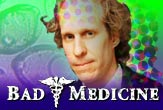Liposuction, The Gift That Sucks

If I truly loved my Dad, I should have gotten him what he really wanted on Father's Day: A $10,000 procedure to insert needles in his body and suck out tiny pockets of fat, blood and other bodily fluids that will ultimately cause his skin to sag and place him at serious risk of death. You might know this as liposuction.
According to the Father's Day advertisements I saw, only a lousy son would give his dad a simple card and hang out with him for the day. Just like mothers (well, according to similar ads in May), fathers want a healthier, new look.
At least part of the ads is true. They will get a new look. Chances are, though, the new look won't be healthier.
Liposuction, the most common cosmetic surgical procedure in the United States, is not for weight loss. At best, the potentially dangerous procedure is safest for skinny people hoping to flatten small flabby regions that can't be toned through exercise. The more fat you want removed, the more dangerous the procedure becomes. Nevertheless, more than 450,000 fat and thin Americans underwent the procedure last year, according to the American Society for Aesthetic Plastic Surgery.
The enduring myth of liposuction—perhaps stemming from its straightforward name and perpetuated in so-called reality shows such as "Extreme Makeover"—is that this is a simple method to suck fat from the body. But the fat doesn't come out without a fight. It is mingled with blood and other fluids that nourish it. The good stuff gets sucked out too.
If too many small arteries and capillaries are destroyed during liposuction, neighboring tissue will die from lack of fresh blood in the weeks to come. So follow-up surgery is often needed to remove dead tissue or run the risk of gangrene. Regardless, swelling lasts for months after a successful liposuction. You'll have stitches and usually little tubes sticking out of your body for a week or two to allow for drainage of leftover, smelly fluid.
Most patients gain the fat back in a few years.
Sign up for the Live Science daily newsletter now
Get the world’s most fascinating discoveries delivered straight to your inbox.
Liposuction is not a weight-loss procedure because, at best, only five or ten pounds of fat can be removed after about four hours of surgery. Removing more fat would take too long and be too dangerous. A doctor would need to make hundreds of incisions up and down your body, draining valuable fluids along the way. The potential for scaring would be high; recovery would be slow and painful.
None of the fat removed by liposuction is that unhealthy anyway. Deadly fat sits within and on top of organs, far from the reach of the liposuction needle. Nor does liposuction remove the fat traveling though and clogging the arteries. That procedure, which has saved countless lives, is called angioplasty.
There are several good things to report about liposuction, though. Deaths are down slightly. That's always a plus for a purely cosmetic procedure. According to the Food and Drug Administration, some studies have estimated over 100 deaths per 100,000 procedures. A safer procedure has been perfected in recent years called tumescent liposuction, in which a saline solution is used to help separate fat from blood. Still, Dr. Luiz Toledo, a Brazilian liposuction expert who trains American doctors, placed the estimate at 1 death per 5,000 procedures, as reported in January in Clinics in Plastic Surgery.
The most common causes of death are infections, tissue damage, fluid loss, gangrene, allergic reaction to anesthesia, and fat embolism, in which a piece of fat is dislodged, enters the blood stream, and blocks blood flow. Minor inconveniences include lumpy or dented skin from uneven fat removal, sagging from a lack of muscle tone to support stretched skin, scarring, and a month or more of bandages and bruises.
Your best bet for a satisfying outcome is with an experienced (that is, very expensive) cosmetic surgeon. Sorry, Dad. Mamma always said to stay away from doctors who advertise in phonebooks and subways.
Christopher Wanjek is the author of the books “Bad Medicine” and “Food At Work.” Got a question about Bad Medicine? Email Wanjek. If it’s really bad, he just might answer it in a future column. Bad Medicine appears each Tuesday on LIveScience.
Related Stories
- Top 10 Mysterious Diseases
- Intestinal Bacteria May Explain Obesity
- U.S. Finally Gets Hip to Replacement Surgery
- The Biggest Popular Myths
More Bad Medicine
- Newborn Screening: Birth Right or Something to Fight?
- Fat Genes: Flawed Logic in New Research Fad
- The Appendix: Slimy But Not Worthless

Christopher Wanjek is a Live Science contributor and a health and science writer. He is the author of three science books: Spacefarers (2020), Food at Work (2005) and Bad Medicine (2003). His "Food at Work" book and project, concerning workers' health, safety and productivity, was commissioned by the U.N.'s International Labor Organization. For Live Science, Christopher covers public health, nutrition and biology, and he has written extensively for The Washington Post and Sky & Telescope among others, as well as for the NASA Goddard Space Flight Center, where he was a senior writer. Christopher holds a Master of Health degree from Harvard School of Public Health and a degree in journalism from Temple University.









